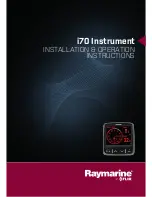
© Vaisala 2014.
All rights reserved.
Page 1 of 2
QUICK START GUIDE
Vaisala vNet PoE
Network Interface
vNet Device Models:
CDL-VNET-LP
CDL-VNET-P (with fan)
CDL-VNET-LPC (15V output)
CDL-VNET-PC (fan and 15V output)
POWER OVER ETHERNET
The Vaisala vNet PoE Network Interface (vNet
Device), provides easy network connectivity for
your Loggers, eliminating the need for an AC
power source if your network supports Power
over Ethernet.
SYSTEM REQUIREMENTS
vNet Device Drivers must be installed on a PC
with the following minimum configuration:
•
Windows XP, Windows Server 2003,
Windows Vista, Windows Server 2008, or
Windows 7 (32 or 64 bit versions)
•
CD-ROM drive
STEP 1: ATTACH HARDWARE
Before you start:
•
If your Logger has an internal temperature
Channel, it must be connected to a vNet
Device with a built-in fan mechanism.
•
If you are mounting a vNet Device on a wall
to hold a built-in fan mechanism, ensure the
vNet Device is in the upright position (the
arrow on the vNet Device bed pointing up).
To connect a Logger to a vNet Device:
1.
Remove protective label on bottom or
back of the Logger.
2.
Slide the Logger as far right as possible
towards the two tabs before pushing
down into the vNet Device bed (you
should hear a ‘click’).
3.
Insert the power supply (if required),
then connect the vNet Device to the
power supply or Ethernet outlet.
Figure 1 Connecting a Logger to a vNet Device
To ensure a secure
connection, insert the
power supply barrel-end
connector into the vNet
Device and turn ¼ to the
right.
If your network supports
Power over Ethernet, you
do not need to connect
an external power
supply
.
Figure 2 Connecting an external power supply
Note: If your vNet Device has Firmware
v1.4 or higher installed (serial no.
1411xxxx), and you are running
viewLinc 4.3 or higher, enabling the
viewLinc Aware Service completes
device driver installation, discovery
and configuration automatically.
Refer to the vNet User’s Guide and
viewLinc User’s Guide for more
information.
STEP 2: INSTALL DRIVERS
Before you start:
•
Obtain an IP address for each vNet device.
If you use reserved IP addresses, the
DHCP server must be updated before you
proceed with the installation.
•
Modify Firewall settings to allow the
dgrunwiz.exe and dgcfgwiz.exe programs
to receive incoming network connections,
and unblock UDP port 2362 and multi-cast
address 224.0.5.128.




















